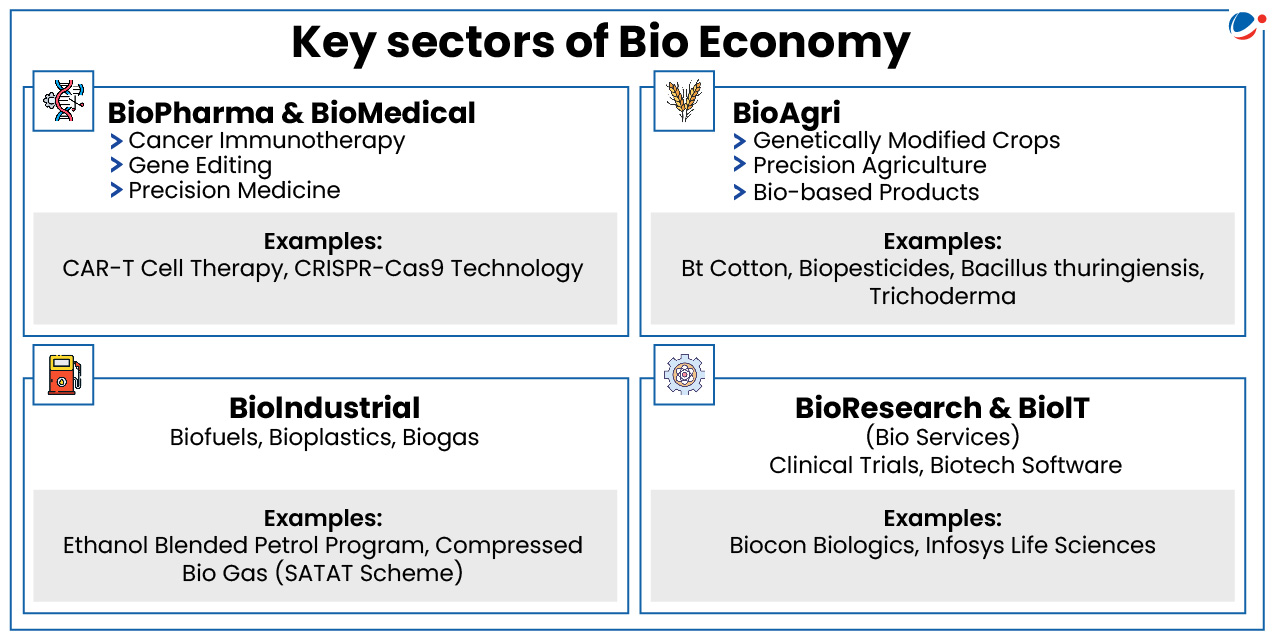Why in the News?
Biotechnology Industry Research Assistance Council (BIRAC) released India Bio-Economy Report 2025 (IBER 2025) on its 13th anniversary.
More on the News
- BioSaarthi Mentorship Initiative, a global mentorship initiative aimed at nurturing biotech startups, was also unveiled.
- Biotechnology Industry Research Assistance Council (BIRAC), set up by Department of Biotechnology in 2012, is a Not-for-profit Public Sector Enterprise.
- It is an industry-academia interface and implements initiatives such as targeted funding, technology transfer, IP management etc.
- Major Initiatives: Bio-NEST Scheme, Biotechnology Ignition Grant (BIG), SEED Fund, LEAP Fund, जनCARE – Amrit Grand Challenge etc.
What is Bio Economy?
- It is the production, utilization and conservation of biological resources, including related knowledge, science, technology, and innovation, to provide information, products, processes and services across all economic sectors aiming toward a sustainable economy.
- India has an ambitious target of $300 billion bioeconomy by 2030.

Significance of Bio-economy for India
- Economic growth: Bioeconomy surged from $10 billion (2014) to $165.7 billion (2024), contributing 4.25% to GDP (IBER 2025).
- Entrepreneurship: Biotech Startups have grown from 50 to 10,000+ in a decade, boosting innovation (IBER 2025).
- Global hub for affordable, quality medicines: India ranks 3rd in pharma production (by volume) and 14th by value.
- Further, India produces 65% of the world's vaccines.
- Food security: BioAgri sector improves agri and livestock productivity through GM crops, precision farming, bio-products, Animal biotech etc.
- E.g., Indian lmmunologicals Limited (Ill) launched "Shashthi," an indigenous In-Vitro Fertilization (IVF) to make IVF technology more affordable for farmers.
- Employment: BioEconomy is projected to create 35 million jobs.
- Energy security: Ethanol blending in India increased from 1.53% in 2014 to 15% in 2024, with a target of 20% by 2025 (IBER 2025).
- This shift has reduced crude oil imports by 173 lakh metric tons and cut 519 lakh metric tons of CO₂ emissions.
- Environmental benefits:
- Promoting Circular Economy: E.g., Second-generation ethanol refineries converting agricultural residues like Parali and bamboo into fuel, Cassava-based bioplastics (Nagaland), etc.
- Pollution Control: Biofertilizers (e.g., Mycorrhizal Bio-fertilisers), biopesticides (E.g., Trichoderma), and bioremediation (E.g., Oilzapper and Oilivorous-S by TERI) reduce chemicals and improve ecosystem health.
- Climate-Smart Crops: E.g., drought-tolerant, high-yielding chickpea variety SAATVIK (NC 9) has been approved for cultivation.
Policies and Schemes promoting Bio economy
|
Hurdles in growth of India's Bioeconomy
- Regulatory and policy issues:
- Overlap, inefficiency, and lack of clarity: India's biotechnology regulations are spread across multiple ministries (Ministry of Environment, Forest and Climate Change, Ministry of Science and Technology etc.) and committees (Genetic Engineering Appraisal Committee (GEAC), Review Committee on Genetic Manipulation, etc.).
- Lack of harmonization in laws: E.g., Contradiction between Protection of Plant Varieties and Farmers' Rights Act with the Patent Act with respect to balancing the rights of farmers and breeders.
- Bio-piracy concerns (theft of biological resources): Traditional Knowledge based on biological resources is often exploited by big multinational companies and pharmaceutical companies.
- E.g., Indian Government objected when US Patent and Trademark Office granted a patent after turmeric.
- Research and Development (Economic Survey 2024-25):
- Low R&D Investment: Gross expenditure on research & development is meager 0.64% of the GDP, which is very low compared to China (~2%) and US (~3%).
- Sectoral Imbalance: Pharma leads with 40%+ of industrial R&D but biotechnology (<10%) and fuel sectors (<10%) lags behind.
- Other issues:
- Safety Concerns related to bio-tech such as containment of biologically active substances, unforeseen ecological consequences of genetically modified crops etc.
- Funding issues like inadequate tax incentives, disparities in sector specific funds etc.
- Lack of adequate Infrastructure for genomic data collection, storage, and analysis etc.
- Supply chain issues, e.g., import dependence for active pharmaceutical ingredients.
- Shortage of professionals trained in bioengineering, molecular biology, genomics etc.
Way Forward
- Reform Policy and Regulatory Framework (IBER 2025) by-
- Creating a National Bio Economy Mission with representation from all stakeholders.
- Establishing a single-window regulatory mechanism for biotech innovations.
- Harmonizing the Protection of Plant Varieties and Farmers' Rights Act with the Patent Act to encourage innovation.
- Leverage international treaties like WIPO's Treaty on Intellectual Property, Genetic Resources and Associated Traditional Knowledge to tackle intellectual properties issues.
- Promote Investment and Funding (IBER 2025) through-
- Targeted tax incentives for R&D investments in biotech especially for private sector research.
- Outcome-based funding mechanisms for high-risk innovations.
- Corporate innovation funds with matching government contributions.
- Encourage Human Capital Development (IBER 2025) by-
- Establishing Centers of Excellence for frontier biotech education.
- Developing specialized curricula for convergent technologies (Bio+AI, Bio+Engineering)
- Establish a National Biological Data Repository and develop Global Alliance Networks for international market access.
- Address Safety risks by utilizing the principle of inherently safer design and a thorough economic, environmental and safety analysis.
- 301st Report of Department Related Parliamentary Standing Committee Report suggested that the process of field trials of GM crops should be done in a closed environment and in consultation with agricultural universities.
Conclusion
The integration of bio-manufacturing, bio-agriculture, and bioenergy enhances national resilience and showcases India's aim to lead in the global bioeconomy. This vision supports a sustainable, self-reliant, and bio-driven economy aligned with India@2047's goals.




